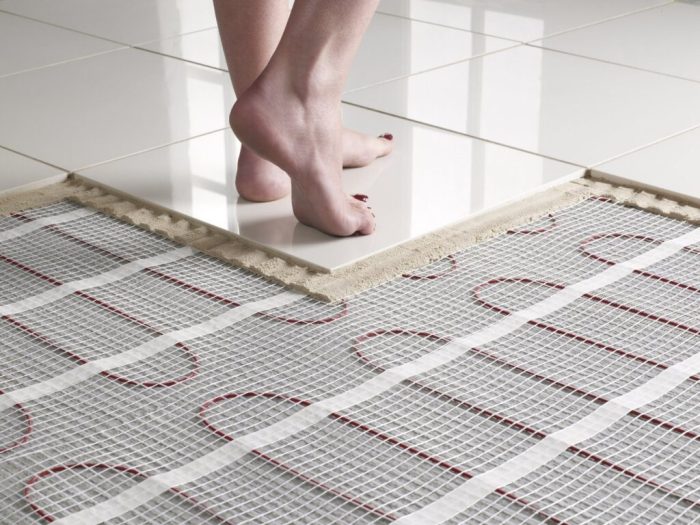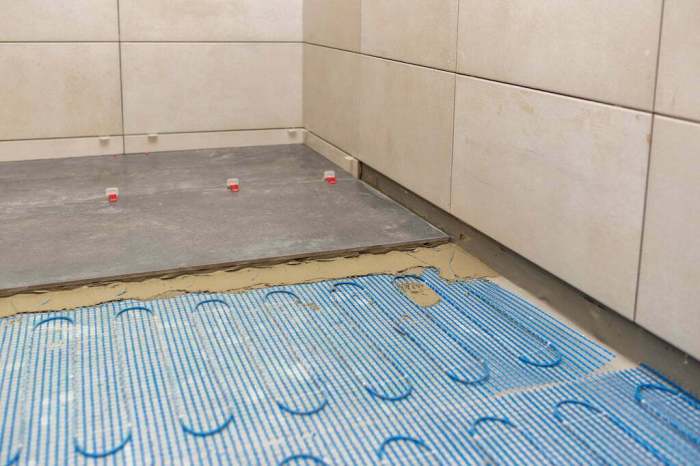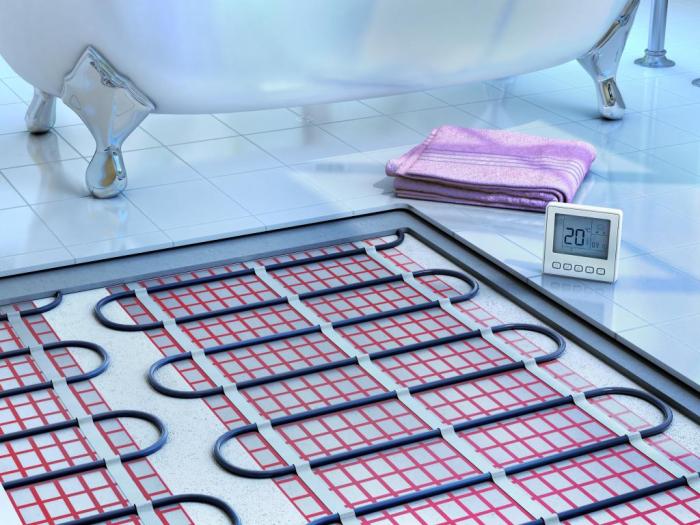Step into the realm of ultimate bathroom bliss with heated underfloor systems. Imagine stepping out of a warm shower onto a toasty floor, enveloping your feet in a comforting embrace. These systems are not just a luxury; they offer a plethora of benefits that will revolutionize your bathroom experience.
Heated underfloor systems are not just a passing trend; they are an investment in comfort, warmth, and energy efficiency. They eliminate cold, drafty floors, creating a cozy ambiance that will make you never want to leave your bathroom.
Benefits of Heated Underfloor Systems for Bathrooms
Heated underfloor systems are an increasingly popular choice for bathrooms, offering a range of benefits that can enhance the comfort, warmth, and energy efficiency of your bathroom space.
One of the primary benefits of heated underfloor systems is the increased comfort they provide. Warm floors are a welcome luxury, especially during the cold winter months, and can help to create a more inviting and relaxing bathroom environment. Heated floors can also help to reduce the risk of slips and falls, as they eliminate the cold, slippery surface that can be common in bathrooms.
Reduced Energy Costs
In addition to providing comfort and warmth, heated underfloor systems can also help to reduce energy costs. By heating the floor rather than the air, underfloor systems can be more efficient than traditional heating methods, as heat is distributed more evenly throughout the room.
This can lead to significant savings on energy bills, especially in larger bathrooms.
Types of Heated Underfloor Systems
Heated underfloor systems are broadly categorized into three main types: electric, hydronic, and geothermal. Each system offers distinct advantages and disadvantages in terms of installation costs, energy efficiency, and maintenance requirements. Understanding these differences is crucial when selecting the most suitable system for your bathroom.
Electric Underfloor Heating
Electric underfloor heating systems utilize electric cables or mats installed beneath the bathroom floor. These cables generate heat when an electric current passes through them, effectively warming the floor and the room above. Electric systems are relatively easy to install and can be retrofitted into existing bathrooms.
However, they tend to have higher operating costs compared to other types due to the continuous consumption of electricity.
Hydronic Underfloor Heating
Hydronic underfloor heating systems circulate warm water through pipes embedded in the floor. The water is heated by a boiler or heat pump, and as it circulates through the pipes, it transfers heat to the floor and the surrounding space.
Hydronic systems offer high energy efficiency and can be integrated with other heating systems, such as solar thermal or geothermal heat pumps. However, installation can be more complex and costly than electric systems.
Geothermal Underfloor Heating
Geothermal underfloor heating systems utilize the Earth’s natural heat to warm the bathroom floor. A network of pipes is installed underground, where they absorb heat from the Earth. This heat is then transferred to the water circulating through the pipes, which in turn warms the floor.
Geothermal systems offer excellent energy efficiency and low operating costs but require specialized equipment and installation expertise, making them more expensive to install initially.
Installation of Heated Underfloor Systems
Installing heated underfloor systems in bathrooms enhances comfort and warmth. The process involves preparing the subfloor, laying the heating elements, and connecting the system to a thermostat.
Preparing the Subfloor
Ensure the subfloor is level, clean, and free of debris. Install a vapor barrier over the subfloor to prevent moisture penetration.
Laying the Heating Elements
Follow the manufacturer’s instructions for laying the heating elements. Electric systems use heating cables or mats, while hydronic systems utilize pipes filled with hot water. Ensure proper spacing and coverage according to the manufacturer’s specifications.
Connecting the System to a Thermostat
Connect the heating elements to a thermostat. The thermostat controls the system’s temperature and can be programmed to provide warmth when needed.
Tips for Successful Installation
* Hire a qualified electrician or plumber for professional installation.
- Test the system before installing the floor covering to ensure proper operation.
- Use appropriate floor coverings that are compatible with heated underfloor systems.
- Follow the manufacturer’s maintenance instructions to ensure longevity and optimal performance.
Design Considerations for Heated Underfloor Systems
When designing heated underfloor systems for bathrooms, several key considerations must be taken into account to ensure optimal performance and comfort.
Room Size and Layout
The size and layout of the bathroom will significantly impact the design of the underfloor heating system. Larger bathrooms will require more heating capacity, while bathrooms with complex layouts may need multiple heating zones to ensure even heat distribution.
Flooring Materials
The type of flooring material used in the bathroom will also affect the design of the underfloor heating system. Tile and stone floors have excellent thermal conductivity, making them ideal for underfloor heating. Carpet and wood floors, on the other hand, have lower thermal conductivity and may require higher heating temperatures.
Heating Capacity and Thermostat Settings
The heating capacity of the underfloor system should be carefully calculated based on the size of the bathroom and the desired comfort level. The thermostat settings should be adjusted to maintain a comfortable floor temperature, typically between 77°F (25°C) and 86°F (30°C).
Integration with Other Bathroom Features
Heated underfloor systems can be integrated with other bathroom features, such as showers and vanities, to provide additional comfort and functionality. For example, heating mats can be installed under showers to prevent cold feet, and heated towel rails can be connected to the underfloor heating system to provide warm towels.
Maintenance and Troubleshooting
Maintaining heated underfloor systems in bathrooms is essential for their optimal performance and longevity. Regular cleaning and inspections are crucial. Additionally, understanding common troubleshooting techniques can help resolve any issues that may arise.
Regular Maintenance
Regularly clean the bathroom floor to remove dirt and debris that can accumulate on the heating system. Avoid using harsh chemicals or abrasive cleaners, as these can damage the system’s components. Vacuum or sweep the floor regularly to prevent dust and debris from clogging the system.
Inspect the system periodically for any signs of damage or wear, such as loose wires or broken tiles.
Case Studies and Examples
Heated underfloor systems have gained popularity in bathrooms, transforming them into cozy and comfortable spaces. Several successful installations showcase the benefits and challenges of different types of systems.
Before-and-After Comparisons
Before-and-after comparisons illustrate the dramatic impact of heated underfloor systems on bathroom comfort and style. Bathrooms previously cold and uninviting become warm and inviting, with a noticeable reduction in dampness and mold.
Case Study: Luxury Hotel Bathroom
A luxury hotel chain installed heated underfloor systems in its bathrooms to enhance the guest experience. The system was designed to provide consistent warmth throughout the bathroom, including the shower area. Guests praised the system for its comfort and convenience, contributing to the hotel’s overall positive reviews.
Case Study: Residential Bathroom Renovation
A homeowner renovated their bathroom with a heated underfloor system to create a spa-like experience. The system was installed beneath ceramic tiles, providing even heat distribution and eliminating cold spots. The homeowner reported a significant increase in comfort and a decrease in energy consumption due to the system’s energy efficiency.
Final Summary
Incorporating a heated underfloor system into your bathroom is a wise decision that will elevate your daily routine and transform your bathroom into a sanctuary of comfort and warmth. With careful planning and installation, you can enjoy the benefits of these systems for years to come, creating a bathroom that is both stylish and functional.



